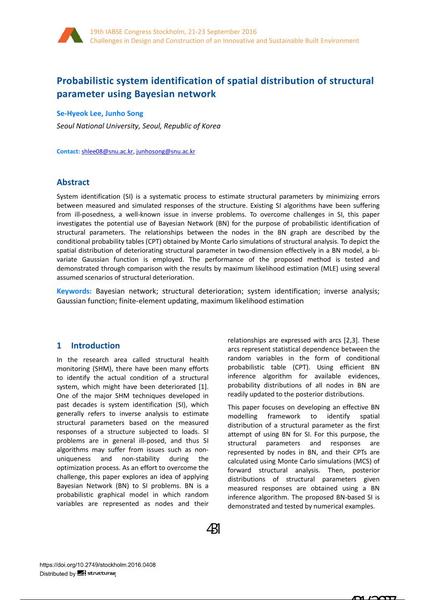Probabilistic system identification of spatial distribution of structural parameter using Bayesian network

|
|
|||||||||||
Bibliographic Details
| Author(s): |
Se Hyeok Lee
(Seoul National University, Seoul, Republic of Korea)
Junho Song (Seoul National University, Seoul, Republic of Korea) |
||||
|---|---|---|---|---|---|
| Medium: | conference paper | ||||
| Language(s): | English | ||||
| Conference: | IABSE Congress: Challenges in Design and Construction of an Innovative and Sustainable Built Environment, Stockholm, Sweden, 21-23 September 2016 | ||||
| Published in: | IABSE Congress Stockholm, 2016 | ||||
|
|||||
| Page(s): | 431-438 | ||||
| Total no. of pages: | 8 | ||||
| Year: | 2016 | ||||
| DOI: | 10.2749/stockholm.2016.0408 | ||||
| Abstract: |
System identification (SI) is a systematic process to estimate structural parameters by minimizing errors between measured and simulated responses of the structure. Existing SI algorithms have been suffering from ill-posedness, a well-known issue in inverse problems. To overcome challenges in SI, this paper investigates the potential use of Bayesian Network (BN) for the purpose of probabilistic identification of structural parameters. The relationships between the nodes in the BN graph are described by the conditional probability tables (CPT) obtained by Monte Carlo simulations of structural analysis. To depict the spatial distribution of deteriorating structural parameter in two-dimension effectively in a BN model, a bi- variate Gaussian function is employed. The performance of the proposed method is tested and demonstrated through comparison with the results by maximum likelihood estimation (MLE) using several assumed scenarios of structural deterioration. |
||||
| Keywords: |
inverse analysis system identification Bayesian network structural deterioration maximum likelihood estimation Gaussian function finite element updating
|
||||
